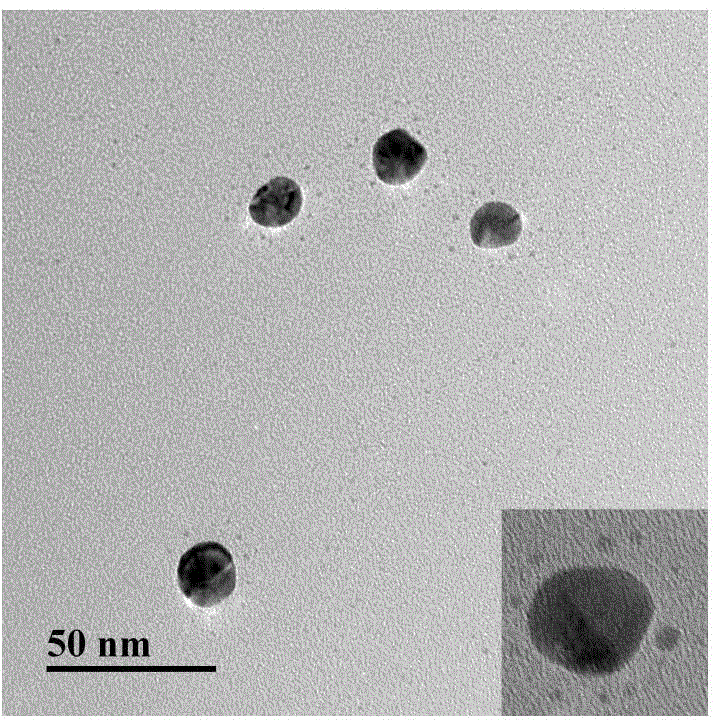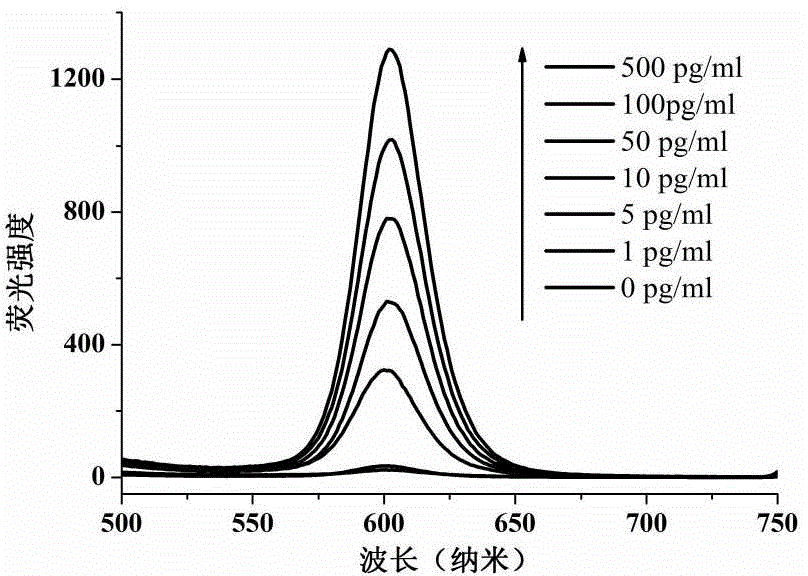Method for detecting bisphenol A based on quantum dot-gold nanoparticle self-assembled superstructure
A detection method and quantum dot technology, applied in the field of analytical chemistry, can solve the problems of low controllability and difficult directional assembly of quantum dots, and achieve the effects of avoiding interference and improving specificity and sensitivity.
- Summary
- Abstract
- Description
- Claims
- Application Information
AI Technical Summary
Problems solved by technology
Method used
Image
Examples
Embodiment 1
[0043] (1) Synthesis of gold nanoparticles
[0044] The preparation method of gold nanoparticles: take a clean Erlenmeyer flask, add 190mL ultrapure water, 10mL 0.2% chloroauric acid solution in turn, heat and stir the solution until boiling, and quickly add 3.6mL 1% trisodium citrate after 7-10min Solution, after the solution turns from colorless to red, stop heating and continue to stir for 15 minutes to make gold nanoparticles, and the concentration of gold nanoparticles is 10nM at this time.
[0045] (2) Synthesis of quantum dots
[0046] Take a clean Erlenmeyer flask, add 390mg Te powder, 189mg sodium borohydride, 4mL ultrapure water in turn, stir at room temperature for 5h until the black Te powder disappears completely, and white sodium borate crystals are produced. Under the protection of nitrogen, mix with H produced by the reaction of 0.5M dilute sulfuric acid 2 Te is passed into the NaOH solution to obtain the NaHTe precursor. Take a clean three-neck flask, add 2...
Embodiment 2
[0053] (1) Synthesis of gold nanoparticles
[0054] The preparation method of gold nanoparticles: take a clean Erlenmeyer flask, add 190mL ultrapure water, 10mL 0.2% chloroauric acid solution, stir the solution and heat it to boiling, and quickly add 3.6mL 1% citric acid three Sodium solution, after the solution turns from colorless to red, stop heating and continue stirring for 15 minutes to make gold nanoparticles.
[0055] (2) Synthesis of quantum dots
[0056] Take a clean Erlenmeyer flask, add 390mg Te powder, 189mg sodium borohydride, 4mL ultrapure water in turn, stir at room temperature for 5h until the black Te powder disappears completely, and white sodium borate crystals are produced. Under the protection of nitrogen, mix with H produced by the reaction of 0.5M dilute sulfuric acid 2 Te was passed into NaOH solution to obtain NaHTe precursor. Take a clean three-neck flask, add 2.6g CdCl successively 2 2.5H 2 O, 148mL water, 0.5mL 98% 3-mercaptopropionic acid, de...
Embodiment 3
[0065] (1) Synthesis of gold nanoparticles
[0066] The preparation method of gold nanoparticles: take a clean Erlenmeyer flask, add 190mL ultrapure water, 10mL 0.2% chloroauric acid solution in turn, stir the solution and heat it to boiling, quickly add 3.6mL 1% citric acid three Sodium solution, after the solution turns from colorless to red, stop heating and continue stirring for 15 minutes to make gold nanoparticles.
[0067] (2) Synthesis of quantum dots
[0068] Take a clean Erlenmeyer flask, add 390mg Te powder, 189mg sodium borohydride in sequence, then add 4mL ultrapure water, stir at room temperature for 5h until the black Te powder disappears completely, and white sodium borate crystals are produced, under nitrogen protection , will react with 0.5M dilute sulfuric acid to generate H 2 Te was passed into NaOH solution to obtain 0.15M NaHTe. Take a clean three-neck flask, add CdCl successively 2 2.5H 2 O, 148mL water, 0.5mL 3-mercaptopropionic acid, nitrogen deox...
PUM
| Property | Measurement | Unit |
|---|---|---|
| Particle size | aaaaa | aaaaa |
| Particle size | aaaaa | aaaaa |
Abstract
Description
Claims
Application Information
 Login to View More
Login to View More - R&D
- Intellectual Property
- Life Sciences
- Materials
- Tech Scout
- Unparalleled Data Quality
- Higher Quality Content
- 60% Fewer Hallucinations
Browse by: Latest US Patents, China's latest patents, Technical Efficacy Thesaurus, Application Domain, Technology Topic, Popular Technical Reports.
© 2025 PatSnap. All rights reserved.Legal|Privacy policy|Modern Slavery Act Transparency Statement|Sitemap|About US| Contact US: help@patsnap.com



